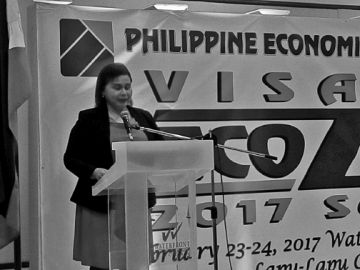
Director General Charito Plaza of the Philippine Economic Zone Authority gives an overview of the office’s new thrust at a forum in Lapu-Lapu City.
CDN PHOTO/VICTOR ANTHONY V. SILVA
Peza chief cites possibility of reviving 10-year proposal amid Cebu’s strong economic performance
Is it time to revive plans to turn the Cebu province into one big ecozone?
Brig. Gen. Charito Plaza, director general of the Philippine Economic Zone Authority (PEZA), said that given Cebu’s strong performance across various sectors, she believed that this plan could be revived.
Plaza described Cebu’s thriving industries as those that had made the province fit to become one whole economic zone, composed of smaller economic zones in each city or municipality.
“There’s still a lot of undeveloped land in the province. That’s why we must not destroy our environment. We must protect it,” Plaza said in a press briefing at the Visayas leg of the PEZA 2017 Ecozone Summit in Lapu-Lapu City on Thursday.
More than 160 representatives from local government units, business groups, locators, and other stakeholders in the Visayas gathered for a two-day confab to identify potential economic zones in Central Philippines.
This was part of PEZA’s thrust to bring development to the countryside, in line with the agenda of the present administration.
CCCI led bid
It was around 10 years ago when local business groups first proposed a province-wide ecozone, but this proposal did not prosper.
A Cebu-wide ecozone is a brainchild of the Cebu Chamber of Commerce and Industry (CCCI), which began seriously considering it in 2006 when Francis Monera was elected chamber president.
Explore possibilities
Current CCCI president Melanie Ng said they would discuss and explore possibilities with the local government units in Cebu to turn the province into a one whole ecozone.
“We are highly energized by the aggressive and strategic plan of Peza to increase the economic viability of our country by coming up with a comprehensive Philippines EcoZones Map,” she said in a text message.
Ng said this would help investors identify opportunities and spread development to the countyside.
Special ecozones
Currently, special economic zones in Cebu City include the South Road Properties, Cebu Business Park, and Asiatown IT Park.
There are also two economic zones in Lapu-Lapu City, and one each in Danao City, Naga City, and Balamban town.
Of these, only the Mactan Export Processing Zone 1 is owned by PEZA, which is among four out of 365 economic zones in the Philippines. The rest are privately owned and managed, although there is still a need for these zones to be registered with the authority.
Peza target
Within President Duterte’s six-year term, Plaza said they target to establish ecozones in every city, town, and province in the Philippines.
This was part of the administration’s thrust to “revolutionize” PEZA, to draw in more investors, utilize idle land, and generate millions of jobs.
PEZA held a similar event for Mindanao in Davao City earlier this month and will hold the final leg for Luzon in Baguio City by March.
Ecozone map
By the end of March, Plaza said PEZA hopes to produce a map of existing and potential ecozones to help prospective locators identify where they want to invest.
“We’ve missed many chances to bring more foreign investors here. Back then, when they’re interested, they depend on whoever they know and often get misinformed or exploited,” said Plaza.
With a consolidated map, she said it will be easier to refer investors to areas that are suited to their respective industries.
This way, development will be brought to the countryside and export capabilities of players will be enhanced.
Kinds of ecozones
Plaza explained that there are different kinds of ecozones in the Philippines.
Based on PEZA data, 74 are industrial export, 249 are IT parks and centers, 19 are tourism-based, two deal with medical tourism, while 21 are agro-industrial.
As of 2016, PEZA investments have reached P218.176 billion while PEZA exports clocked in $47.93 billion.
There are currently 3,916 PEZA locators across the country, 30 percent of which are Japanese firms, 22.31 percent are Filipino-owned, while the rest are American, Dutch, and British, among others.
Jobs, incentives
PEZA-registered ecominic zones in the country employ 1.36 million as of December last year.
Among the incentives and benefits offered by PEZA are income tax holidays of up to 8 years; special 5-percent tax on gross income in lieu of all national and local taxes after the holiday; exemption from duties and taxes on imported capital equipment, parts, supplies, and materials; and zero Value-Added Tax.
The investment areas given incentives include export manufacturing, IT and Business Process Outsourcing services, tourism, medical tourism, agro-industrial export manufacturing, and logistics, among others.